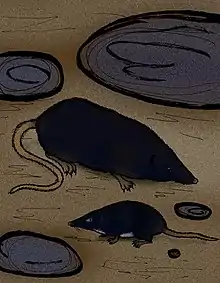Balearic shrew
The Balearic shrew (Nesiotites hidalgo) is an extinct species of shrew from Majorca and Menorca, in the Balearic Islands of Spain, belonging to the endemic genus Nesiotites. It was one of three native land mammals to the Balearic Islands, alongside Myotragus and Hypnomys. Nesotites has been present in the Balearic Islands for over 5 million years since the Late Miocene-Early Pliocene, and is the final and largest chronospecies of the lineage. It was relatively large for a shrew, being estimated to weigh between 20 to 30 grams.[2] Among living shrews it is most closely related to the Himalayan shrew, from which it diverged around 6.44 million years ago and has a probable close relationship with the extinct genus Asoriculus of mainland Europe and Corsica-Sardinia.[3]
| Balearic shrew[1] | |
|---|---|
 | |
| Comparison of N. hidalgo, and a water shrew | |
| Scientific classification | |
| Kingdom: | Animalia |
| Phylum: | Chordata |
| Class: | Mammalia |
| Order: | Eulipotyphla |
| Family: | Soricidae |
| Genus: | †Nesiotites |
| Species: | †N. hidalgo |
| Binomial name | |
| †Nesiotites hidalgo Bate, 1945 | |
| Synonyms | |
|
Asoriculus hidalgo | |
See also
References
- Hutterer, R. (2005). "Order Soricomorpha". In Wilson, D.E.; Reeder, D.M (eds.). Mammal Species of the World: A Taxonomic and Geographic Reference (3rd ed.). Johns Hopkins University Press. p. 280. ISBN 978-0-8018-8221-0. OCLC 62265494.
- Moncunill-Solé, Blanca; Jordana, Xavier; Köhler, Meike (September 2016). "How common is gigantism in insular fossil shrews? Examining the 'Island Rule' in soricids (Mammalia: Soricomorpha) from Mediterranean Islands using new body mass estimation models". Zoological Journal of the Linnean Society. 178 (1): 163–182. doi:10.1111/zoj.12399.
- Bover, Pere; Mitchell, Kieren J.; Llamas, Bastien; Rofes, Juan; Thomson, Vicki A.; Cuenca-Bescós, Gloria; Alcover, Josep A.; Cooper, Alan; Pons, Joan (August 2018). "Molecular phylogenetics supports the origin of an endemic Balearic shrew lineage (Nesiotites) coincident with the Messinian Salinity Crisis". Molecular Phylogenetics and Evolution. 125: 188–195. doi:10.1016/j.ympev.2018.03.028. PMID 29608962.